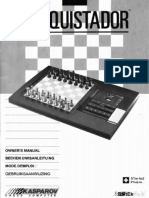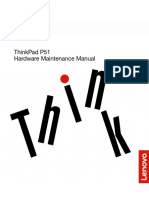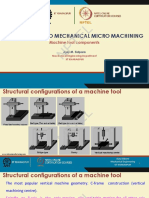What Is Arduino?
Uploaded by
Zakaria MourtadiWhat Is Arduino?
Uploaded by
Zakaria MourtadiARDUINO
What is arduino?
Arduino is an open-source platform used for building electronics projects. Arduino consists of both
a physical programmable circuit board (often referred to as a microcontroller) and a piece of
software, or IDE (Integrated Development Environment) that runs on your computer, used to write
and upload computer code to the physical board.
The Arduino platform has become quite popular with people just starting out with electronics, and
for good reason. Unlike most previous programmable circuit boards, the Arduino does not need a
separate piece of hardware (called a programmer) in order to load new code onto the board -- you
can simply use a USB cable. Additionally, the Arduino IDE uses a simplified version of C++,
making it easier to learn to program. Finally, Arduino provides a standard form factor that breaks
out the functions of the micro-controller into a more accessible package
HISTORY OF ARDUINO :
In 2005, in Ivrea, Italy, a project was initiated to make a device for controlling student-built
interactive design projects that was less expensive than other prototyping systems available at the
time. One of the cofounders, Massimo Banzi, named this piece of hardware Arduino in honor of Bar
di Re Arduino (In 1002, King Arduin became the ruler of the Italy. Today, the Bar di Re Arduino, a
pub on a cobblestoned street in town, honors his memory), and began producing boards in a small
factory located in the same region as the computer company Olivetti.
The Arduino project is a fork of the open source Wiring platform and is programmed using a
Wiring-based language (syntax and libraries), similar to C++ with some slight simplifications and
modifications, and a Processing-based integrated development environment (IDE).
Arduino was built around the Wiring project of Hernando Barragan. Wiring was Hernando's thesis
project at the Interaction Design Institute Ivrea. It was intended to be an electronic version of
Processing that used our programming environment and was patterned after the Processing syntax.
Arduino would not exist without Wiring and Wiring would not exist without Processing.
Currently, there are more than 200 distributors of Arduino products around the world. About 80
percent of people who buy this product are from the United States and Europe. The interest in this
product is rising in the China, India, and South America markets. Over the years, new designs of the
Arduino have been created. The original design is called the Arduino Uno. Some of the Arduino
designs are the Arduino Mega, Arduino Nano, LilyPad Arduino, and Arduino Ethernet. This past
year, the Arduino gained publicity by partnering with Google. Google released the Android ADK, or
Accessory Development Kit, which is based on the Anduino. A person can build an Android app
that uses the Phone’s camera, motion sensors, touch screen, and internet connectivity. It looks as
though the Arduino is creating a new, cheaper way of programming. It does not seem to be going
away any time soon; it is only getting more popular.
Why Arduino Boards ?
Arduino board has been used for making different engineering projects and different applications.
The Arduino software is very simple to use for beginners, yet flexible adequate for advanced users.
It runs Windows, Linux, and Mac. Teachers and students in the schools utilize it to design low-cost
scientific instruments to verify the principles of physics and chemistry. There are numerous other
microcontroller platforms obtainable for physical computing. The Netmedia’s BX-24, Parallax
Basic Stamp, MIT’s Handyboard, Phidget, and many others present related functionality.
Arduino also makes simpler the working process of microcontroller, but it gives some advantages
over other systems for teachers, students, and beginners.
Inexpensive (Its price is between 1000 da and 2000da)
Cross-platform
The simple, clear programming environment
Open source and extensible software
Open source and extensible hardware
The Function of the Arduino Board
The flexibility of the Arduino board is enormous so that one can do anything they imagine. This
board can be connected very easily to different modules such as obstacle sensors, presence
detectors, fire sensors, GSM Modules GPS modules, etc. The main function of the Arduino board is
to control electronics through reading inputs & changing it into outputs because this board works
like a tool. This board is also used to make different electronics projects in the field of electronics,
electrical, robotics, etc.
Types Of Arduino Boards
Arduino Uno (R3)
Arduino Nano
Arduino Micro
Arduino Due
LilyPad Arduino Board
Arduino Bluetooth
Arduino Diecimila
RedBoard Arduino Board
Arduino Mega (R3) Board
Arduino Leonardo Board
Arduino Robot
Arduino Esplora
Arduino Pro Mic
Arduino Ethernet
Arduino Zero
Fastest Arduino Board
most used «Arduino Uno » :
Arduino Uno (R3)
The Uno is a huge option for your initial Arduino. This Arduino board depends on an ATmega328P
based microcontroller. As compared with other types of arduino boards, it is very simple to use like
the Arduino Mega type board. .It consists of 14-digital I/O pins, where 6-pins can be used as
PWM(pulse width modulation outputs), 6-analog inputs, a reset button, a power jack, a USB
connection, an In-Circuit Serial Programming header (ICSP), etc. It includes everything required to
hold up the microcontroller; simply attach it to a PC with the help of a USB cable and give the
supply to get started with an AC-to-DC adapter or battery.
Arduino Software IDE :
• Arduino IDE is an open-source software, designed by Arduino.cc and mainly used for
writing, compiling & uploading code to almost all Arduino Modules.
• It is an official Arduino software, making code compilation too easy that even a common
person with no prior technical knowledge can get their feet wet with the learning process.
• It is available for all operating systems i.e. MAC, Windows, Linux and runs on the Java
Platform that comes with inbuilt functions and commands that play a vital role in debugging,
editing and compiling the code.
• A range of Arduino modules available including Arduino Uno, Arduino Mega, Arduino
Leonardo,Arduino Micro and many more.
• Each of them contains a microcontroller on the board that is actually programmed and
accepts the information in the form of code.
• The main code, also known as a sketch, created on the IDE platform will ultimately generate
a Hex File which is then transferred and uploaded in the controller on the board.
• The IDE environment mainly contains two basic parts: Editor and Compiler where former is
used for writing the required code and later is used for compiling and uploading the code into the
given Arduino Module.
• This environment supports both C and C++ langage.
The following example shows how to turn the LED on for 1 second (1000 milliseconds) and
off for one second continuously until the Arduino is disconnected from the power source:
int LED_PIN =13;
void setup () {
pinMode (13, OUTPUT);
}
void loop () {
digitalWrite(LED_PIN,HIGH);
delay(1000);
digitalWrite(LED_PIN,LOW);
delay(1000);
}
Here is another code to turn the LED off and on via Bluetooth:
int x;
void setup () {
Serial.begin(9600);
pinMode(3,OUTPUT);
}
void loop () {
if (Serial.available())
{
x=Serial.read();
if (x=='1')
{
digitalWrite(3,HIGH);
}
else
{
digitalWrite(3,LOW);
}
}
}
You might also like
- Manual Taller Outlook (Dierre) 125 Efi (Idioma Ingles)89% (9)Manual Taller Outlook (Dierre) 125 Efi (Idioma Ingles)173 pages
- Model Based Software Design: Massimo ViolanteNo ratings yetModel Based Software Design: Massimo Violante27 pages
- Instruction Sets: Addressing Modes and Formats: William Stallings, Computer Organization and Architecture, 9 EditionNo ratings yetInstruction Sets: Addressing Modes and Formats: William Stallings, Computer Organization and Architecture, 9 Edition31 pages
- C++ Tutorial: ECE 250 Data Structures and AlgorithmsNo ratings yetC++ Tutorial: ECE 250 Data Structures and Algorithms14 pages
- Using Python As Primary Language For Teaching Programming100% (1)Using Python As Primary Language For Teaching Programming9 pages
- Proposal Offer Paper Bill Board AdvertisingNo ratings yetProposal Offer Paper Bill Board Advertising4 pages
- Grade - 9 Computer Engineering - C-ProgrammingNo ratings yetGrade - 9 Computer Engineering - C-Programming77 pages
- Leisure - Invitational Chess TournamentNo ratings yetLeisure - Invitational Chess Tournament26 pages
- Manual. ChessBase Account First Steps 12-2022No ratings yetManual. ChessBase Account First Steps 12-20227 pages
- Lego Mindstorms NXT Hardware Developer KitNo ratings yetLego Mindstorms NXT Hardware Developer Kit25 pages
- FIDE Trainers' Commission (TRG) FIDE Trainers' System (Regulations) FIDE Titles - TRG SeminarsNo ratings yetFIDE Trainers' Commission (TRG) FIDE Trainers' System (Regulations) FIDE Titles - TRG Seminars7 pages
- ECF Arbiter Exam Syllabus As of January 2017No ratings yetECF Arbiter Exam Syllabus As of January 20174 pages
- Thinkpad P51 Hardware Maintenance ManualNo ratings yetThinkpad P51 Hardware Maintenance Manual122 pages
- Chess Explained The English Opening 1st Edition Zenon Franco download pdf100% (9)Chess Explained The English Opening 1st Edition Zenon Franco download pdf81 pages
- Chess - Ebook - Combinatorial Game Theory in Chess EndgamesNo ratings yetChess - Ebook - Combinatorial Game Theory in Chess Endgames16 pages
- Discovering Chess Openings Building Opening Skills From Basic Principles by John Emms Z-Liborg (Dragged)No ratings yetDiscovering Chess Openings Building Opening Skills From Basic Principles by John Emms Z-Liborg (Dragged)1 page
- Przewoznik Soszynski-How To Think in Chess PDFNo ratings yetPrzewoznik Soszynski-How To Think in Chess PDF287 pages
- Two Moves Checkmate Chess Book Games for Kids and Beginners: The Right Way to Learn Chess With Chess Lessons and Chess ExercisesFrom EverandTwo Moves Checkmate Chess Book Games for Kids and Beginners: The Right Way to Learn Chess With Chess Lessons and Chess ExercisesNo ratings yet
- Opening Tactics in The French: The Classical Variation: Opening Tactics, #5From EverandOpening Tactics in The French: The Classical Variation: Opening Tactics, #5No ratings yet
- Programming LEGO® EV3 My Blocks: Teaching Concepts and Preparing for FLL® CompetitionFrom EverandProgramming LEGO® EV3 My Blocks: Teaching Concepts and Preparing for FLL® CompetitionNo ratings yet
- Job # 4. Base Line Measurement Using Jaderin's Method100% (1)Job # 4. Base Line Measurement Using Jaderin's Method6 pages
- 25 Hardest Questions From The GMAT Club Forum Solutions PDFNo ratings yet25 Hardest Questions From The GMAT Club Forum Solutions PDF11 pages
- Inventory Record Inaccuracy and Store Level PerformanceNo ratings yetInventory Record Inaccuracy and Store Level Performance16 pages
- Formatting Documents in APA Style (7th Edition) With The Apa7 L TEX ClassNo ratings yetFormatting Documents in APA Style (7th Edition) With The Apa7 L TEX Class19 pages
- ECH3121 - Assignment 1 (PROCESS IDENTIFICATION OF AIR FRYER)No ratings yetECH3121 - Assignment 1 (PROCESS IDENTIFICATION OF AIR FRYER)28 pages
- 5.4.3 Term Structure Model and Interest Rate Trees: Example 5.12 BDT Tree CalibrationNo ratings yet5.4.3 Term Structure Model and Interest Rate Trees: Example 5.12 BDT Tree Calibration5 pages
- Lecture Notes-An Introduction to Differential EquationsNo ratings yetLecture Notes-An Introduction to Differential Equations4 pages
- ShortMathColoringWorksheetThankaTeacherTeacherAppreciation-1No ratings yetShortMathColoringWorksheetThankaTeacherTeacherAppreciation-110 pages

























































































